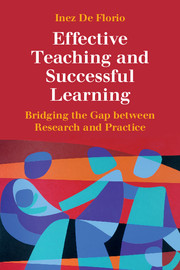Book contents
- Frontmatter
- Epigraph
- Contents
- Preface
- Introduction
- 1 Main Features of Scientific Research on Education
- 2 Important Types of Scientific Research on Education
- 3 Main Features of Evidence-based Research on Education
- 4 Meta-Analyses on Education
- 5 A Synthesis of Over 800 Meta-Analyses Relating to Achievement
- 6 Scaffolding Effective Teaching and Successful Learning
- 7 Planning and Starting the Lesson
- 8 Presenting Knowledge and Skills – Assertive Questioning
- 9 Guided and Independent Practice
- 10 Cooperative and Project-based Learning
- 11 Feedback – Reciprocal and Informative
- Concluding Remarks: Standards Need More Evidence
- References
- Index
8 - Presenting Knowledge and Skills – Assertive Questioning
Published online by Cambridge University Press: 05 June 2016
- Frontmatter
- Epigraph
- Contents
- Preface
- Introduction
- 1 Main Features of Scientific Research on Education
- 2 Important Types of Scientific Research on Education
- 3 Main Features of Evidence-based Research on Education
- 4 Meta-Analyses on Education
- 5 A Synthesis of Over 800 Meta-Analyses Relating to Achievement
- 6 Scaffolding Effective Teaching and Successful Learning
- 7 Planning and Starting the Lesson
- 8 Presenting Knowledge and Skills – Assertive Questioning
- 9 Guided and Independent Practice
- 10 Cooperative and Project-based Learning
- 11 Feedback – Reciprocal and Informative
- Concluding Remarks: Standards Need More Evidence
- References
- Index
Summary
The presentation phase is the core unit of Direct Instruction or Interactive Whole-class Teaching. It is the most decisive phase of the Model of Effective Teaching (MET), too. As aforementioned, DI and similar teaching models are not to be confused with didactic teaching, which consists of one-way teacher-guided transmission of knowledge learned through repetition or rote learning.
Any scrupulously planned lesson or teaching unit will reach your learners only in part (or not at all) if you do not eliminate disruptive behavior or distractions as far as possible. At the outset of your teaching in a particular class, you should clarify the rules and routines of classroom and learning behavior with your students. Do you remember the advice of Esmé Raji Codell (see Section 1.5) to be consistent? “It means you do what you say and you say what you mean,” telling the students: “This is the way we do things around here,” sticking to articulated rules, procedures, and consequences without walking right into the trap of “inflexibility” (2009, p. 244).
Liem and Martin invite teachers to carefully “sequence lessons that comprise appropriately scripted/well-thought through instructions” (Liem & Martin, 2013, p. 368). Whereas Hattie's research into DI is limited to measurable achievement of college and university students, Liem and Martin's overview of research evidence is more differentiated and detailed. On the one hand, they describe empirical studies demonstrating “the effectiveness of various DI programs relative to other programs” (ibid., p. 366). On the other, they illustrate the varying results of DI in different subject matters and their dependence on student ability.
Their research report is not limited to cognitive achievement. Liem and Martin underscore the positive affective outcomes of DI, which are often negated by its critics. Furthermore, DI is in accordance with constructivist approaches, as it promotes the construction of knowledge and skills through well-sequenced systematic steps during the presentation phase and the following guided and independent practice (ibid., p. 368).
What is evident for DI programs on the whole is also demonstrated for single components of DI through empirical, mostly experimental, research findings. “Ongoing debates (see e.g., Kirschner, Sweller and Clark, 2006; Mayer, 2004; Tobias and Duff, 2009) have contrasted the achievement yield of DI and its various procedural components with that of minimally guided instructional approaches, including discovery learning, problem based learning, and enquiry-based learning” (ibid., p. 367).
- Type
- Chapter
- Information
- Effective Teaching and Successful LearningBridging the Gap between Research and Practice, pp. 137 - 156Publisher: Cambridge University PressPrint publication year: 2016



